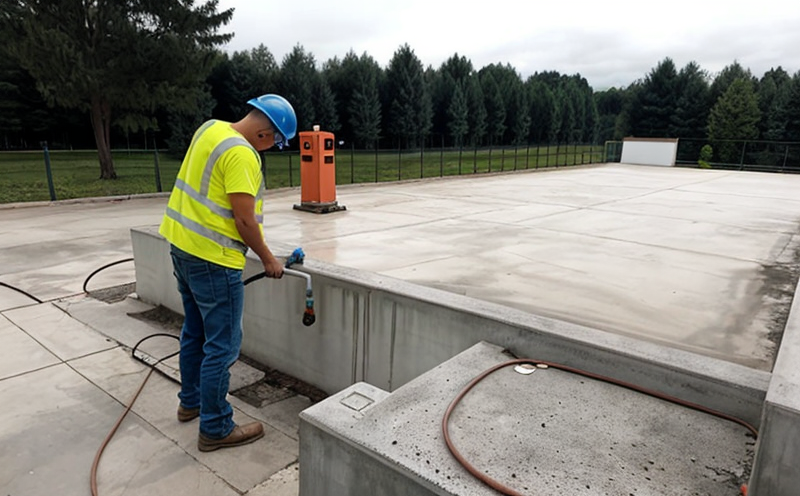Concrete curing inspection
The process of concrete curing is critical to ensure that the concrete achieves its full design strength and durability. Concrete curing involves providing a controlled environment for hydration, which is essential for the development of compressive strength in hardened concrete. This service focuses on inspecting the curing conditions during this vital stage.
Concrete curing typically involves four stages: mixing, placement or pouring, finishing, and curing. The quality managers play a significant role in ensuring that all these stages are carried out correctly to achieve optimal results. Concrete curing inspection ensures that each of these stages is completed properly and within the specified time frame.
The importance of concrete curing cannot be overstated as it directly impacts the durability, longevity, and performance of the construction project. Proper curing helps prevent cracking and other defects in the structure, ensuring a strong foundation for any building or infrastructure project. This service focuses on providing detailed inspections to ensure that all aspects of the curing process are met.
Curing is a complex process involving multiple factors such as temperature, humidity, water content, and time. The inspection involves monitoring these parameters closely throughout the curing period. Proper curing helps prevent alkali-silica reaction (ASR), sulfate attack, and other chemical reactions that can lead to structural damage. Ensuring proper curing also enhances fire resistance by reducing the risk of carbonation.
During concrete curing inspections, various methods are used depending on the specific requirements of the project. These may include visual inspections using magnifying lenses or specialized equipment like thermometers and humidity meters. In some cases, core samples might be taken to evaluate the strength of the cured concrete. The inspection process ensures that all aspects of the curing process meet the required standards.
The quality of concrete is determined by its ability to resist external forces such as compression, tension, or impact. By monitoring the curing conditions closely and ensuring they adhere to industry standards, we can guarantee high-quality construction projects. Concrete curing inspections are an essential part of this process, providing peace of mind knowing that all elements have been addressed correctly.
Concrete curing inspection services play a crucial role in ensuring compliance with relevant codes and regulations. For instance, ASTM C1012 specifies the requirements for curing concrete specimens using plastic sheeting or other means to maintain moisture during early-age strength development. Similarly, EN 206 provides guidance on the production of concrete mixtures suitable for specific applications.
| Application | Description |
|---|---|
| Data Centers | Curing ensures that the concrete foundation supports heavy equipment and maintains stability over time. |
| Highways and Bridges | Proper curing is critical for ensuring the structural integrity of highways and bridges, particularly those exposed to harsh weather conditions. |
| Airports | Curing helps maintain runway strength and durability, which is essential for safe aircraft operations. |
| Residential Buildings | In residential construction, curing ensures that the foundation can support the weight of the building and resist moisture intrusion. |
Applied Standards
To ensure the highest quality in concrete curing inspections, this service adheres to several international standards. These include ASTM C1012 for curing specimens using plastic sheeting or other means during early-age strength development, EN 206 for producing concrete mixtures suitable for specific applications, and ISO 9001 for quality management systems.
- ASTM C1012: Specification for Curing Concrete Specimens Using Plastic Sheet Covers
- EN 206: Code of Practice for Concrete in Building
- ISO 9001: Quality Management Systems - Requirements
Industry Applications
Concrete curing inspections are essential across various industries, particularly those involving large-scale infrastructure projects. In data centers, for example, the concrete foundation must be strong enough to support heavy servers and other equipment while maintaining stability over time.
- Data Centers: Ensuring that the concrete foundation supports heavy equipment and maintains stability
- Highways and Bridges: Critical for ensuring structural integrity of highways and bridges, especially those exposed to harsh weather conditions
- Airports: Maintaining runway strength and durability is essential for safe aircraft operations
- Residential Buildings: Ensuring that the foundation can support the weight of the building and resist moisture intrusion
Competitive Advantage and Market Impact
Congressional Research Services (CRS) have highlighted the importance of proper curing in reducing construction defects, which can lead to significant cost savings for both developers and property owners. By adhering to stringent inspection protocols, this service helps reduce the risk of costly repairs and replacements.
- Reduction in construction defects
- Cost savings for developers and property owners through reduced repair costs
- Enhanced reputation among clients due to consistent quality control practices





